冀教版八年级下册Unit 7 Know Our World Lesson 40 Body Language课件(共34张PPT)
文档属性
| 名称 | 冀教版八年级下册Unit 7 Know Our World Lesson 40 Body Language课件(共34张PPT) |
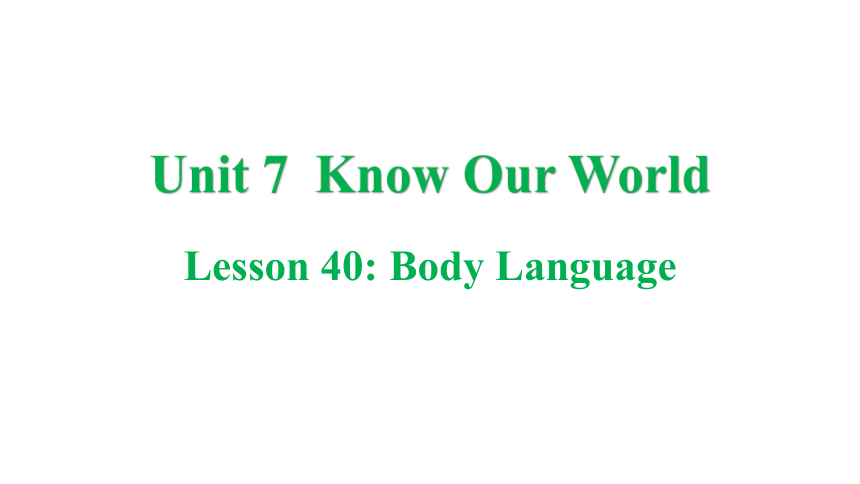
|
|
| 格式 | pptx | ||
| 文件大小 | 580.6KB | ||
| 资源类型 | 教案 | ||
| 版本资源 | 冀教版 | ||
| 科目 | 英语 | ||
| 更新时间 | 2024-05-02 18:17:57 | ||
图片预览

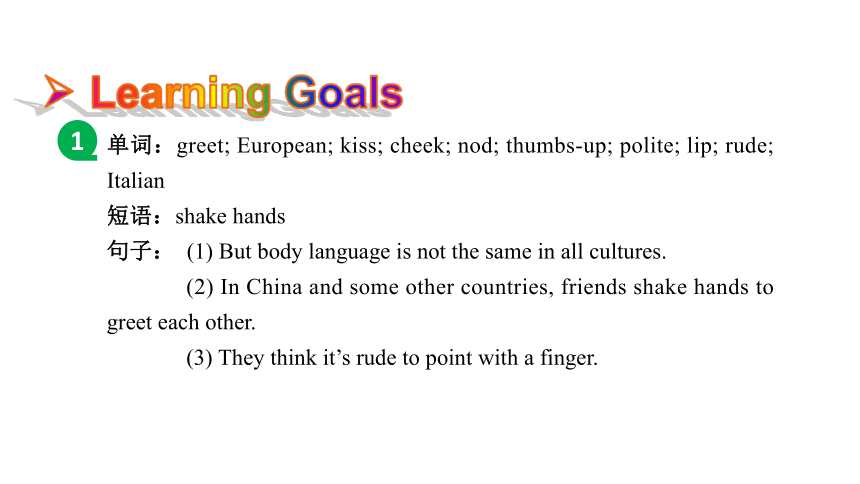
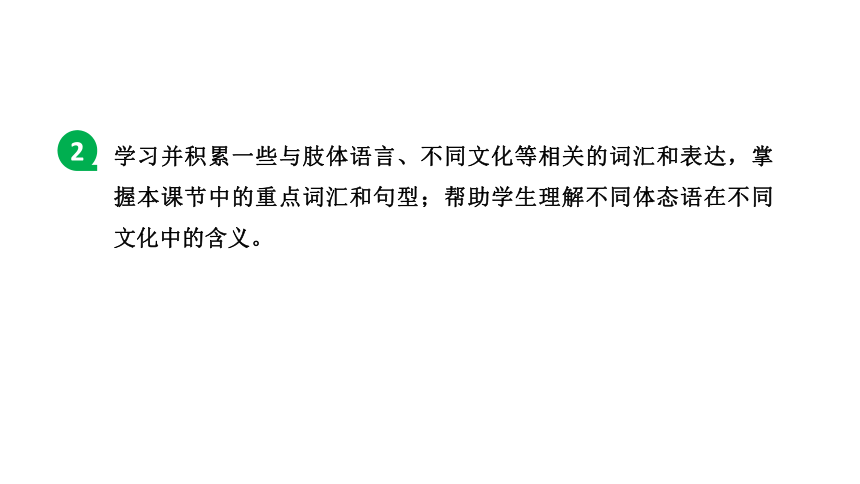

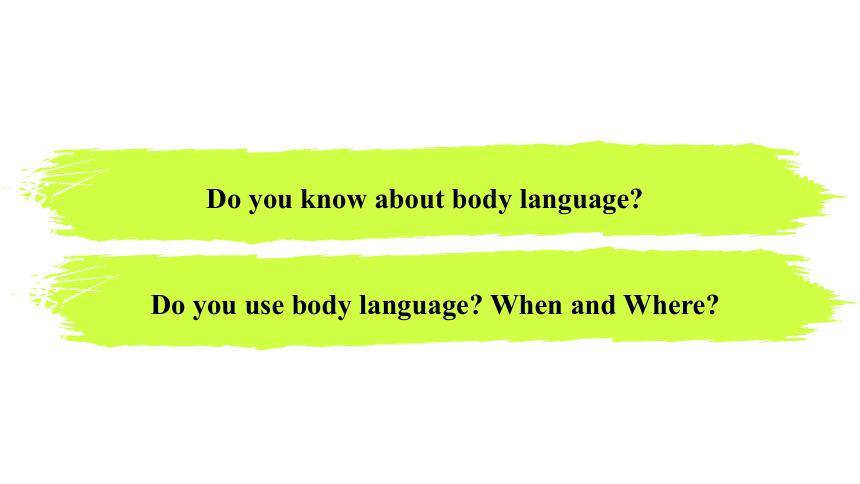
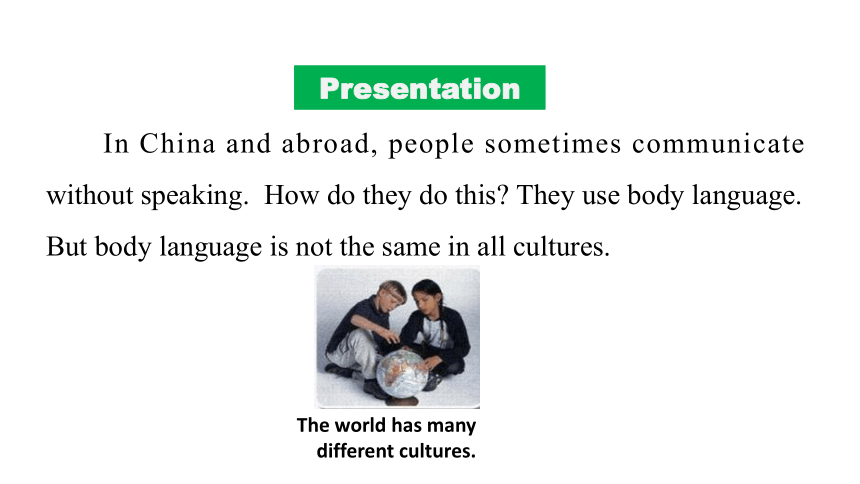
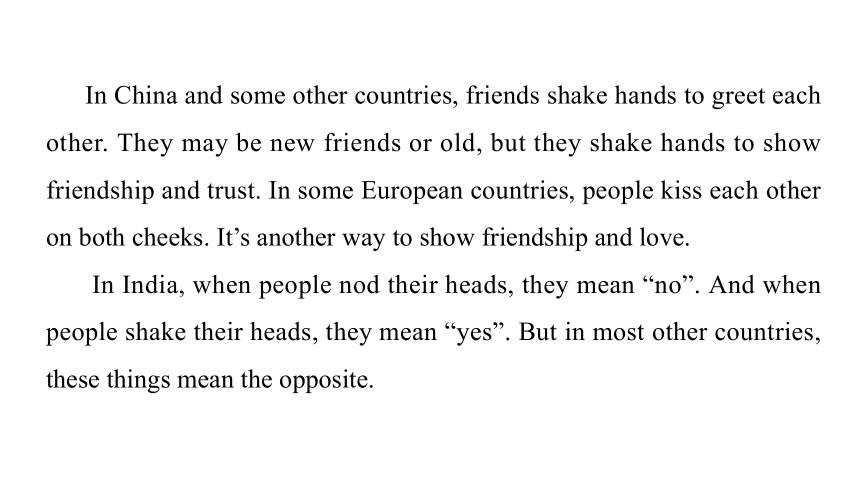
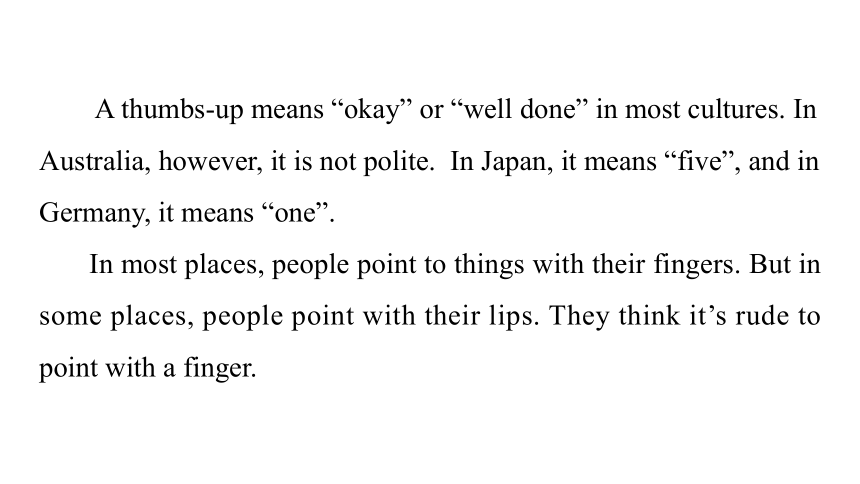
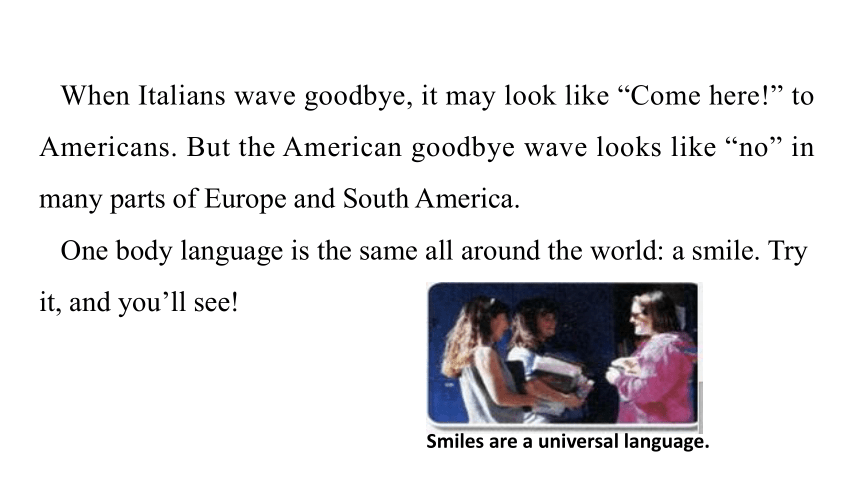
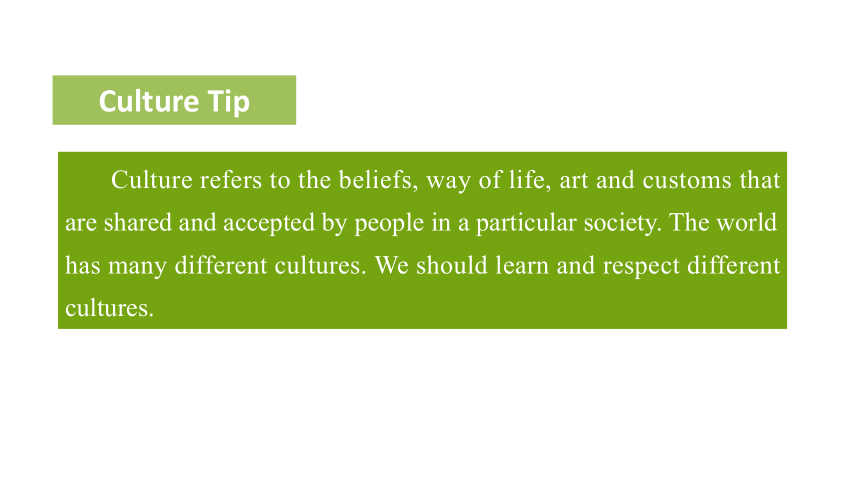
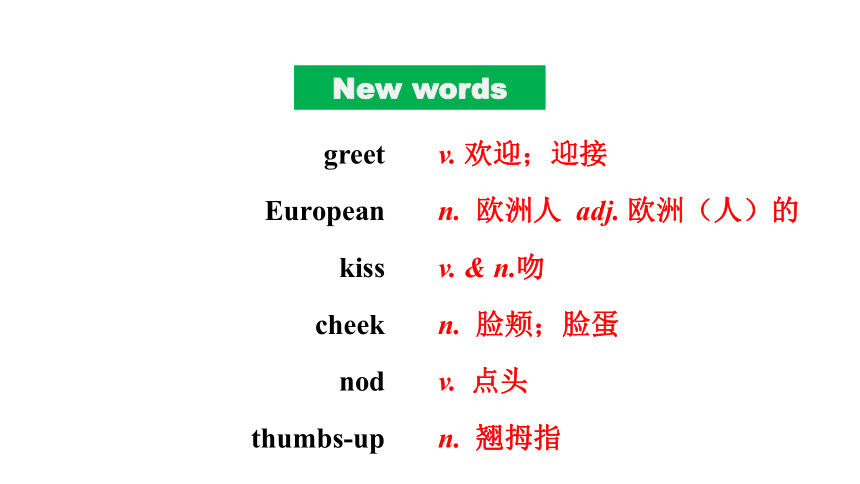
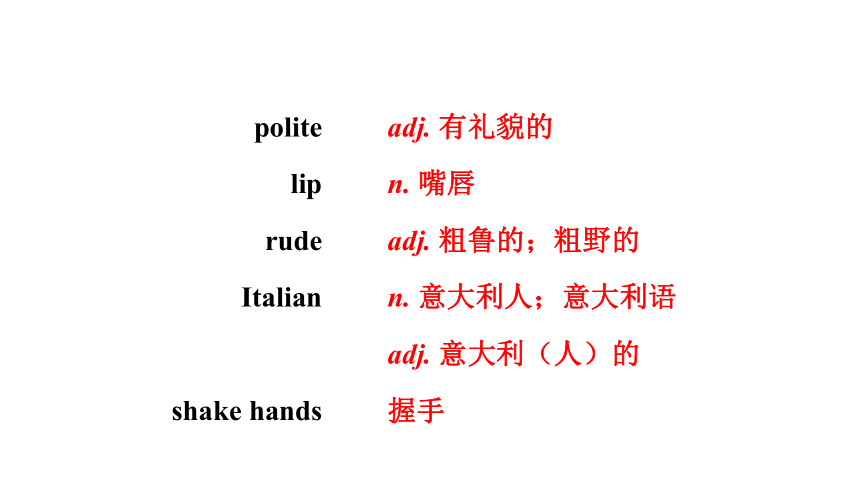
文档简介
(共34张PPT)
Lesson 40: Body Language
Unit 7 Know Our World
单词:greet; European; kiss; cheek; nod; thumbs-up; polite; lip; rude; Italian
短语:shake hands
句子: (1) But body language is not the same in all cultures.
(2) In China and some other countries, friends shake hands to greet each other.
(3) They think it’s rude to point with a finger.
Learning Goals
1
学习并积累一些与肢体语言、不同文化等相关的词汇和表达,掌握本课节中的重点词汇和句型;帮助学生理解不同体态语在不同文化中的含义。
2
Free Talk
Do you know what the following body language mean
How do people greet others in different countries
Do you know about body language
Do you use body language When and Where
Presentation
In China and abroad, people sometimes communicate without speaking. How do they do this They use body language. But body language is not the same in all cultures.
The world has many
different cultures.
In China and some other countries, friends shake hands to greet each other. They may be new friends or old, but they shake hands to show friendship and trust. In some European countries, people kiss each other on both cheeks. It’s another way to show friendship and love.
In India, when people nod their heads, they mean “no”. And when people shake their heads, they mean “yes”. But in most other countries, these things mean the opposite.
A thumbs-up means “okay” or “well done” in most cultures. In Australia, however, it is not polite. In Japan, it means “five”, and in Germany, it means “one”.
In most places, people point to things with their fingers. But in some places, people point with their lips. They think it’s rude to point with a finger.
When Italians wave goodbye, it may look like “Come here!” to Americans. But the American goodbye wave looks like “no” in many parts of Europe and South America.
One body language is the same all around the world: a smile. Try it, and you’ll see!
Smiles are a universal language.
Culture Tip
Culture refers to the beliefs, way of life, art and customs that are shared and accepted by people in a particular society. The world has many different cultures. We should learn and respect different cultures.
New words
greet
European
kiss
cheek
nod
thumbs-up
v. 欢迎;迎接
n. 欧洲人 adj. 欧洲(人)的
v. & n.吻
n. 脸颊;脸蛋
v. 点头
n. 翘拇指
polite
lip
rude
Italian
shake hands
adj. 有礼貌的
n. 嘴唇
adj. 粗鲁的;粗野的
n. 意大利人;意大利语
adj. 意大利(人)的
握手
Let's do it!
3. Fill in the blanks with the words in this lesson. The first letter is given.
1. His mother k him goodbye every morning when she leaves for work.
2. A: What do you do when you meet new friends
B: I say hello and s hands with them.
3. If you agree, please n your head.
4. Italy is a E country. It has a long history.
5. It’s p to say “thank you” when someone helps you.
isses
hake
od
uropean
olite
Let's do it!
1. Read the lesson and write true (T) or false (F) .
1. In some European countries, people like to kiss each other to show friendship and love. ( )
2. Nodding your head means “yes” and shaking your head means “no” everywhere in the world. ( )
3. A thumbs- up means “well done” in Germany. ( )
4. When Americans wave goodbye, it looks like “no” in some European countries. ( )
T
F
F
T
Let's do it!
2. Read the lesson again and complete the table.
kiss each other on both cheeks
in China and some
other countries
no
in Australia
in Germany
in India
Language points
1. In China and abroad, people sometimes communicate without speaking. 在中国和国外,人们有时候不用语言交流。
(1)辨析:sometimes,some times,sometime与some time
① sometimes adv.有时
※ Every man is a fool sometimes, but none at all times.
每个人有时都会犯傻,但没有谁会一直都傻。
② some times 几次。此时time作可数名词,意为“次数”。
※ I am sure that we have met some times before.
我肯定我们之前见过几次了。
③ sometime adv.某个时候。它可指过去或将来的某个时候。
※ We’ll take our holiday sometime in August.
我们会在八月的某时度假。(将来)
※ I bought this sometime last summer.
这是我在去年夏天某个时候买的。(过去)
④ some time 一段时间。它常与for连用。
※ We plan to stay in Hainan for some time.
我们打算在海南待上一段时间。
(2) communicate交流;沟通(不及物动词)
communicate with sb. 与某人交流
communicate in 用……语言交流
※ Mary can communicate with strangers very well.
玛丽能和陌生人交流得很好。
※ They communicate in slogan.
他们用口号交流。
2. But body language is not the same in all cultures. 但是肢体语言并不是在所有文化中都相同。
该句是一个不完全否定的句子。
“not the same in all cultures”译为“并非在所有的文化中都是一样的”,而不能翻译成“在所有的文化中都是不一样的”。
※ Not all students are here today.
今天并非所有的学生都到了。
3. In China and some other countries, friends shake hands to greet each other. 在中国和其他一些国家,朋友们通过握手来问候对方。
shake hands 握手。shake hands with sb.和某人握手。
※ Shaking hands is very common in China.
在中国握手很常见。
注意:握手要两只手才能进行,所以在shake hands短语中hand一定要用复数。
4. In some European countries, people kiss each other on both cheeks. 在一些欧洲国家,人们相互亲吻双颊。
(1) European n. 欧洲人 adj. 欧洲(人)的
European用作名词时是可数名词。
一个欧洲人:a European,其复数形式为Europeans。
※ She is the only European in the class.
她是班上仅有的欧洲人。
※ Germany is a European country.
德国是一个欧洲国家。
(2) kiss v.亲吻
“kiss sb. on +身体部位” 意为“亲吻某人的……(身体部位)”。
※ The children like kissing their mothers on the cheeks.
孩子们喜欢亲吻妈妈的脸颊。
5. In India, when people nod their heads, they mean “no”. 在印度,当人们点头时,他们的意思是“不”。
nod v. 点头。它多用于表示同意或打招呼等。
作及物动词时,可接名词或代词作宾语,也可接双宾语;作不及物动词时,其后常接介词to或at,也可接动词不定式作目的状语。
※ He nodded his head sympathetically.
他同情地点点头。
※ She nodded when she passed me in the street.
她在街上走过我身旁时向我点了点头。
6. But in most other countries, these things mean the opposite. 但在其他国家,这些肢体语言表达的意思却是相反的。
opposite adj.相反的 n.对立面;对立的人(或物)
opposite 常用于:
① be the opposite of:是……的对立面;是……的反义词
※ Fast is the opposite of slow.
快是慢的反义词。
② the opposite direction:相反的方向
※ He drove off in the opposite direction.
他开车向相反的方向驶去。
7. In Australia, however, it is not polite. 但是在澳大利亚,这是不礼貌的。
(1) however adv.然而。多位于句中,有时也放在句首或句尾,其后用逗号将其与后面的句子隔开。
※ His first response was to say no. Later, however, he changed his mind.
他最初的反应是不同意。可是后来他改变了主意。
(2) polite adj.有礼貌的。polite→politely→impolite。其反义词为impolite,意为“没有礼貌的”。
※ be polite to sb.对某人有礼貌。
※ Being polite in public is necessary. 在公共场所有礼貌是很有必要的。
8. They think it’s rude to point with a finger. 他们认为用一个手指指人是粗鲁的。
rude adj.粗鲁的;无礼的
It’s rude to do sth. 做某事是粗鲁的。
be rude to sb. 对某人粗鲁
※ Don’t be rude to old people.
不要对老人粗鲁。
9. Culture refers to the beliefs... 文化指的是信仰……
refer to 涉及;指的是;参考;提到
※ The latter meaning may refer to Hawaii’s volcanoes.
后一则意思也许是指夏威夷的火山。
※ His letter didn’t refer to you.
他的信中没有提到你。
※ Can’t you refer to the dictionary
你就不能查查字典吗?
Practice
I.用方框内所给词语的正确形式填空。
polite nod European shake hands culture
1. The lady _____________ with my mother just now.
2. In the distance, my teacher is _________ her head to show her agreement.
3. ________________like eating beef.
4. There are many different __________ around the world.
5. After getting the prize, the girl said “Thanyou!” _________ with smile.
shook hands
nodding
Europeans
cultures
politely
politely
II.用括号内所给单词的适当形式填空。
1. Asia is the world’s _________ (large) continent.
2. More than two _________ (billion) people live on the island.
3. What is the main _____________ (geography) feature of that country
geographical
largest
billion
III.句型转换,每空一词。
1. There are over two hundred people in the hall. (改为同义句)
There are ________ ________ two hundred people in the hall.
2. Lin Tao is the tallest student in our class. (对划线部分提问)
_________ is the tallest student in your class
3. The Great Wall is very famous all over the world. (改为感叹句)
_________ _________ the Great Wall is all over the world!
How famous
more than
Who
Sum up
1. The new words:
greet; European; kiss; cheek; nod; thumbs-up; polite; lip; rude; Italian
2. Important phrases:
shake hands
3. Important sentences:
(1) But body language is not the same in all cultures.
(2) In China and some other countries, friends shake hands to greet each other.
(3) They think it’s rude to point with a finger.
Homework
1. Remember the new words and expressions learnt in this lesson.
2. Preview Lesson 41.
Lesson 40: Body Language
Unit 7 Know Our World
单词:greet; European; kiss; cheek; nod; thumbs-up; polite; lip; rude; Italian
短语:shake hands
句子: (1) But body language is not the same in all cultures.
(2) In China and some other countries, friends shake hands to greet each other.
(3) They think it’s rude to point with a finger.
Learning Goals
1
学习并积累一些与肢体语言、不同文化等相关的词汇和表达,掌握本课节中的重点词汇和句型;帮助学生理解不同体态语在不同文化中的含义。
2
Free Talk
Do you know what the following body language mean
How do people greet others in different countries
Do you know about body language
Do you use body language When and Where
Presentation
In China and abroad, people sometimes communicate without speaking. How do they do this They use body language. But body language is not the same in all cultures.
The world has many
different cultures.
In China and some other countries, friends shake hands to greet each other. They may be new friends or old, but they shake hands to show friendship and trust. In some European countries, people kiss each other on both cheeks. It’s another way to show friendship and love.
In India, when people nod their heads, they mean “no”. And when people shake their heads, they mean “yes”. But in most other countries, these things mean the opposite.
A thumbs-up means “okay” or “well done” in most cultures. In Australia, however, it is not polite. In Japan, it means “five”, and in Germany, it means “one”.
In most places, people point to things with their fingers. But in some places, people point with their lips. They think it’s rude to point with a finger.
When Italians wave goodbye, it may look like “Come here!” to Americans. But the American goodbye wave looks like “no” in many parts of Europe and South America.
One body language is the same all around the world: a smile. Try it, and you’ll see!
Smiles are a universal language.
Culture Tip
Culture refers to the beliefs, way of life, art and customs that are shared and accepted by people in a particular society. The world has many different cultures. We should learn and respect different cultures.
New words
greet
European
kiss
cheek
nod
thumbs-up
v. 欢迎;迎接
n. 欧洲人 adj. 欧洲(人)的
v. & n.吻
n. 脸颊;脸蛋
v. 点头
n. 翘拇指
polite
lip
rude
Italian
shake hands
adj. 有礼貌的
n. 嘴唇
adj. 粗鲁的;粗野的
n. 意大利人;意大利语
adj. 意大利(人)的
握手
Let's do it!
3. Fill in the blanks with the words in this lesson. The first letter is given.
1. His mother k him goodbye every morning when she leaves for work.
2. A: What do you do when you meet new friends
B: I say hello and s hands with them.
3. If you agree, please n your head.
4. Italy is a E country. It has a long history.
5. It’s p to say “thank you” when someone helps you.
isses
hake
od
uropean
olite
Let's do it!
1. Read the lesson and write true (T) or false (F) .
1. In some European countries, people like to kiss each other to show friendship and love. ( )
2. Nodding your head means “yes” and shaking your head means “no” everywhere in the world. ( )
3. A thumbs- up means “well done” in Germany. ( )
4. When Americans wave goodbye, it looks like “no” in some European countries. ( )
T
F
F
T
Let's do it!
2. Read the lesson again and complete the table.
kiss each other on both cheeks
in China and some
other countries
no
in Australia
in Germany
in India
Language points
1. In China and abroad, people sometimes communicate without speaking. 在中国和国外,人们有时候不用语言交流。
(1)辨析:sometimes,some times,sometime与some time
① sometimes adv.有时
※ Every man is a fool sometimes, but none at all times.
每个人有时都会犯傻,但没有谁会一直都傻。
② some times 几次。此时time作可数名词,意为“次数”。
※ I am sure that we have met some times before.
我肯定我们之前见过几次了。
③ sometime adv.某个时候。它可指过去或将来的某个时候。
※ We’ll take our holiday sometime in August.
我们会在八月的某时度假。(将来)
※ I bought this sometime last summer.
这是我在去年夏天某个时候买的。(过去)
④ some time 一段时间。它常与for连用。
※ We plan to stay in Hainan for some time.
我们打算在海南待上一段时间。
(2) communicate交流;沟通(不及物动词)
communicate with sb. 与某人交流
communicate in 用……语言交流
※ Mary can communicate with strangers very well.
玛丽能和陌生人交流得很好。
※ They communicate in slogan.
他们用口号交流。
2. But body language is not the same in all cultures. 但是肢体语言并不是在所有文化中都相同。
该句是一个不完全否定的句子。
“not the same in all cultures”译为“并非在所有的文化中都是一样的”,而不能翻译成“在所有的文化中都是不一样的”。
※ Not all students are here today.
今天并非所有的学生都到了。
3. In China and some other countries, friends shake hands to greet each other. 在中国和其他一些国家,朋友们通过握手来问候对方。
shake hands 握手。shake hands with sb.和某人握手。
※ Shaking hands is very common in China.
在中国握手很常见。
注意:握手要两只手才能进行,所以在shake hands短语中hand一定要用复数。
4. In some European countries, people kiss each other on both cheeks. 在一些欧洲国家,人们相互亲吻双颊。
(1) European n. 欧洲人 adj. 欧洲(人)的
European用作名词时是可数名词。
一个欧洲人:a European,其复数形式为Europeans。
※ She is the only European in the class.
她是班上仅有的欧洲人。
※ Germany is a European country.
德国是一个欧洲国家。
(2) kiss v.亲吻
“kiss sb. on +身体部位” 意为“亲吻某人的……(身体部位)”。
※ The children like kissing their mothers on the cheeks.
孩子们喜欢亲吻妈妈的脸颊。
5. In India, when people nod their heads, they mean “no”. 在印度,当人们点头时,他们的意思是“不”。
nod v. 点头。它多用于表示同意或打招呼等。
作及物动词时,可接名词或代词作宾语,也可接双宾语;作不及物动词时,其后常接介词to或at,也可接动词不定式作目的状语。
※ He nodded his head sympathetically.
他同情地点点头。
※ She nodded when she passed me in the street.
她在街上走过我身旁时向我点了点头。
6. But in most other countries, these things mean the opposite. 但在其他国家,这些肢体语言表达的意思却是相反的。
opposite adj.相反的 n.对立面;对立的人(或物)
opposite 常用于:
① be the opposite of:是……的对立面;是……的反义词
※ Fast is the opposite of slow.
快是慢的反义词。
② the opposite direction:相反的方向
※ He drove off in the opposite direction.
他开车向相反的方向驶去。
7. In Australia, however, it is not polite. 但是在澳大利亚,这是不礼貌的。
(1) however adv.然而。多位于句中,有时也放在句首或句尾,其后用逗号将其与后面的句子隔开。
※ His first response was to say no. Later, however, he changed his mind.
他最初的反应是不同意。可是后来他改变了主意。
(2) polite adj.有礼貌的。polite→politely→impolite。其反义词为impolite,意为“没有礼貌的”。
※ be polite to sb.对某人有礼貌。
※ Being polite in public is necessary. 在公共场所有礼貌是很有必要的。
8. They think it’s rude to point with a finger. 他们认为用一个手指指人是粗鲁的。
rude adj.粗鲁的;无礼的
It’s rude to do sth. 做某事是粗鲁的。
be rude to sb. 对某人粗鲁
※ Don’t be rude to old people.
不要对老人粗鲁。
9. Culture refers to the beliefs... 文化指的是信仰……
refer to 涉及;指的是;参考;提到
※ The latter meaning may refer to Hawaii’s volcanoes.
后一则意思也许是指夏威夷的火山。
※ His letter didn’t refer to you.
他的信中没有提到你。
※ Can’t you refer to the dictionary
你就不能查查字典吗?
Practice
I.用方框内所给词语的正确形式填空。
polite nod European shake hands culture
1. The lady _____________ with my mother just now.
2. In the distance, my teacher is _________ her head to show her agreement.
3. ________________like eating beef.
4. There are many different __________ around the world.
5. After getting the prize, the girl said “Thanyou!” _________ with smile.
shook hands
nodding
Europeans
cultures
politely
politely
II.用括号内所给单词的适当形式填空。
1. Asia is the world’s _________ (large) continent.
2. More than two _________ (billion) people live on the island.
3. What is the main _____________ (geography) feature of that country
geographical
largest
billion
III.句型转换,每空一词。
1. There are over two hundred people in the hall. (改为同义句)
There are ________ ________ two hundred people in the hall.
2. Lin Tao is the tallest student in our class. (对划线部分提问)
_________ is the tallest student in your class
3. The Great Wall is very famous all over the world. (改为感叹句)
_________ _________ the Great Wall is all over the world!
How famous
more than
Who
Sum up
1. The new words:
greet; European; kiss; cheek; nod; thumbs-up; polite; lip; rude; Italian
2. Important phrases:
shake hands
3. Important sentences:
(1) But body language is not the same in all cultures.
(2) In China and some other countries, friends shake hands to greet each other.
(3) They think it’s rude to point with a finger.
Homework
1. Remember the new words and expressions learnt in this lesson.
2. Preview Lesson 41.
同课章节目录
- Unit 1 Spring Is Coming
- Lesson 1 How's the weather?
- Lesson 2 It's Getting Warmer!
- Lesson 3 Sun Is Rising
- Lesson 4 The Spring City
- Lesson 5 Babysitting on a Spring Day
- Lesson 6 Stories about Spring
- Unit 2 Plant a Plant
- Lesson 7 Planting Trees
- Lesson 8 Why Are Plants Important?
- Lesson 9 Gardening with Mary
- Lesson 10 Make Your Garden Grow!
- Lesson 11 Amazing Plants
- Lesson 12 Danny's Plant
- Unit 3 Animals Are Our Friends
- Lesson 13 Danny's Big Scare
- Lesson 14 Amazing Animals
- Lesson 15 The Zoo Is Open
- Lesson 16 The Pear Escaped
- Lesson 17 Save the Tigers
- Lesson 18 Friendship Between Animals
- Unit 4 The Internet Connects Us
- Lesson 19 How Do You Use the Internet?
- Lesson 20 A Computer Helps!
- Lesson 21 Books or Computers?
- Lesson 22 Travel on the Internet
- Lesson 23 The Internet--Good or Bad?
- Lesson 24 An E-mail to Grandpa
- Unit 5 Buying and Selling
- Lesson 25 Raising Money
- Lesson 26 Cookies, Please!
- Lesson 27 Business English
- Lesson 28 Ms. Liu's Great Idea
- Lesson 29 How to Push a Product
- Lesson 30 A Cookie Sale
- Unit 6 Be a Champion!
- Lesson 31 Don't Fall, Danny
- Lesson 32 My Favourite Record
- Lesson 33 2800 Years of Sports
- Lesson 34 Modern Olympics
- Lesson 35 The Dream Team
- Lesson 36 Classroom Olympics
- Unit 7 Know Our World
- Lesson 37 Let's Learn Geography!
- Lesson 38 The World Is a Big Place
- Lesson 39 Ring Up or Call?
- Lesson 40 Body Language
- Lesson 41 A Class of the World
- Lesson 42 North America
- Unit 8 Save Our World
- Lesson 43 Let's Clean Up!
- Lesson 44 Environment Clubs
- Lesson 45 Let's Sort Garbage!
- Lesson 46 Protect Our Environment
- Lesson 47 Connected to Nature
- Lesson 48 Garbage Is Interesting!
